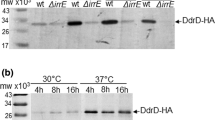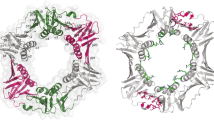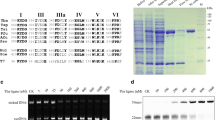Abstract
We report the identification and characterization of the single-stranded DNA-binding protein (SSB) from the mesophile and highly radiation-resistant Deinococcus radiopugnans (DrpSSB). PCR-derived DNA fragment containing the complete structural gene for DrpSSB protein was cloned and expressed in Escherichia coli. The gene consisting of an open reading frame of 900 nucleotides encodes a protein of 300 amino acids with a calculated molecular weight of 32.45 kDa and pI 5.34. The amino acids sequence exhibits 43, 44, 79 and 18% identity with Thermus aquaticus, Thermus thermophilus, Deinococcus radiodurans and E. coli SSBs, respectively. The DrpSSB includes two OB folds per monomer and functions as a homodimer. In fluorescence titrations with poly(dT), DrpSSB bound 24–31 nt depending on the salt concentration, and fluorescence was quenched by about 80%. In a complementation assay in E. coli, DrpSSB took over the in vivo function of EcoSSB. The half-lives of DrpSSB were 120 min at 90°C, 60 min at 95°C and 30 min at 100°C. These results were surprising in the context of half-life of SSB from thermophilic T. aquaticus, which has only 30 s of half-life at 95°C. DrpSSB is the most thermostable SSB-like protein identified to date, offering an attractive alternative for TaqSSB and TthSSB in their applications for molecular biology methods and analytical purposes.





Similar content being viewed by others
Abbreviations
- dsDNA:
-
Double-stranded DNA
- OB fold:
-
Oligonucleotide/oligosaccharide-binding fold
- RPA:
-
Replication protein A
- SSB:
-
Single-stranded DNA binding
References
Atrazhev A, Zhang S, Grosse F (1992) Single-stranded DNA binding protein from calf thymus. Purification, properties, and stimulation of the homologous DNA-polymerase-alpha-primase complex. Eur J Biochem 210(3):855–865
Bernstein DA, Eggington JM, Killoran MP, Misic AM, Cox MM, Keck JL (2004) Crystal structure of the Deinococcus radiodurans single-stranded DNA-binding protein suggests a mechanism for coping with DNA damage. Proc Natl Acad Sci USA 101(23):8575–8580
Curth U, Genschel J, Urbanke C, Greipel J (1996) In vitro and in vivo function of the C-terminus of Escherichia coli single-stranded DNA binding protein. Nucleic Acids Res 24(14):2706–2711
Dąbrowski S, Kur J (1999) Cloning, overexpression, and purification of the recombinant His-tagged SSB protein of Escherichia coli and use in polymerase chain reaction amplification. Protein Expr Purif 16(1):96–102
Dąbrowski S, Olszewski M, Piatek R, Brillowska-Dabrowska A, Konopa G, Kur J (2002a) Identification and characterization of single-stranded-DNA-binding proteins from Thermus thermophilus and Thermus aquaticus—new arrangement of binding domains. Microbiology 148(Pt 10):3307–3315
Dąbrowski S, Olszewski M, Piatek R, Kur J (2002b) Novel thermostable ssDNA-binding proteins from Thermus thermophilus and T. aquaticus—expression and purification. Protein Expr Purif 26(1):131–138
Eggington JM, Haruta N, Wood EA, Cox MM (2004) The single-stranded DNA-binding protein of Deinococcus radiodurans. BMC Microbiol 4:2
Genschel J, Litz L, Thole H, Roemling U, Urbanke C (1996) Isolation, sequencing and overproduction of the single-stranded DNA binding protein from Pseudomonas aeruginosa PAO. Gene 182(1–2):137–143
de Groot A, Chapon V, Servant P, Christen R, Saux MF, Sommer S, Heulin T (2005) Deinococcus deserti sp. nov., a gamma-radiation-tolerant bacterium isolated from the Sahara Desert. Int J Syst Evol Microbiol 55(Pt 6):2441–2446
Handa P, Acharya N, Varshney U (2001) Chimeras between single-stranded DNA-binding proteins from Escherichia coli and Mycobacterium tuberculosis reveal that their C-terminal domains interact with uracil DNA glycosylases. J Biol Chem 276(20):16992–16997
Hirsch P, Gallikowski CA, Siebert J, Peissl K, Kroppenstedt R, Schumann P, Stackebrandt E, Anderson R (2004) Deinococcus frigens sp. nov., Deinococcus saxicola sp. nov., and Deinococcus marmoris sp. nov., low temperature and draught-tolerating, UV-resistant bacteria from continental Antarctica. Syst Appl Microbiol 27(6):636–645
Karshikoff A, Ladenstein R (2001) Ion pairs and the thermotolerance of proteins from hyperthermophiles: a “traffic rule” for hot roads. Trends Biochem Sci 26(9):550–556
Korolev S, Nayal M, Barnes WM, Di Cera E, Waksman G (1995) Crystal structure of the large fragment of Thermus aquaticus DNA polymerase I at 2.5-A resolution: structural basis for thermostability. Proc Natl Acad Sci USA 92(20):9264–9268
Kur J, Olszewski M, Długołęcka A, Filipkowski P (2005) Single-stranded DNA-binding proteins (SSBs)—sources and applications in molecular biology. Acta Biochim Pol 52(3):569–574
Ladenstein R, Antranikian G (1998) Proteins from hyperthermophiles: stability and enzymatic catalysis close to the boiling point of water. Adv Biochem Eng Biotechnol 61:37–85
Matsumoto T, Morimoto Y, Shibata N, Kinebuchi T, Shimamoto N, Tsukihara T, Yasuoka N (2000) Roles of functional loops and the C-terminal segment of a single-stranded DNA binding protein elucidated by X-ray structure analysis. J Biochem (Tokyo) 127(2):329–335
Matthews BW, Nicholson H, Becktel WJ (1987) Enhanced protein thermostability from site-directed mutations that decrease the entropy of unfolding. Proc Natl Acad Sci USA 84(19):6663–6667
Murzin AG (1993) OB(oligonucleotide/oligosaccharide binding)-fold: common structural and functional solution for non-homologous sequences. EMBO J 12(3):861–867
Omelchenko MV, Wolf YI, Gaidamakova EK, Matrosova VY, Vasilenko A, Zhai M, Daly MJ, Koonin EV, Makarova KS (2005) Comparative genomics of Thermus thermophilus and Deinococcus radiodurans: divergent routes of adaptation to thermophily and radiation resistance. BMC Evol Biol 5:57
Porter RD, Black S (1991) The single-stranded-DNA-binding protein encoded by the Escherichia coli F factor can complement a deletion of the chromosomal ssb gene. J Bacteriol 173(8):2720–2723
Raghunathan S, Kozlov AG, Lohman TM, Waksman G (2000) Structure of the DNA binding domain of E. coli SSB bound to ssDNA. Nat Struct Biol 7(8):648–652
Scandurra R, Consalvi V, Chiaraluce R, Politi L, Engel PC (1998) Protein thermostability in extremophiles. Biochimie 80(11):933–941
Schwarz G, Watanabe F (1983) Thermodynamics and kinetics of co-operative protein–nucleic acid binding. I. General aspects of analysis of data. J Mol Biol 163(3):467–484
Shamoo Y, Friedman AM, Parsons MR, Konigsberg WH, Steitz TA (1995) Crystal structure of a replication fork single-stranded DNA binding protein (T4 gp32) complexed to DNA. Nature 376(6538):362–366
Stassen MJ, Bailey D, Nelson S, Chinwalla V, Harte PJ (1995) The Drosophila trithorax proteins contain a novel variant of the nuclear receptor type DNA binding domain and an ancient conserved motif found in other chromosomal proteins. Mech Dev 52(2–3):209–223
Urbanke C, Schaper A (1990) Kinetics of binding of single-stranded DNA binding protein from Escherichia coli to single-stranded nucleic acids. Biochemistry 29(7):1744–1749
Van den Burg B, Dijkstra BW, Vriend G, Van der Vinne B, Venema G, Eijsink VG (1994) Protein stabilization by hydrophobic interactions at the surface. Eur J Biochem 220(3):981–985
Wadsworth RI, White MF (2001) Identification and properties of the crenarchaeal single-stranded DNA binding protein from Sulfolobus solfataricus. Nucleic Acids Res 29(4):914–920
Webster G, Genschel J, Curth U, Urbanke C, Kang C, Hilgenfeld R (1997) A common core for binding single-stranded DNA: structural comparison of the single-stranded DNA-binding proteins (SSB) from E. coli and human mitochondria. FEBS Lett 411(2–3):313–316
Williams KR, Konigsberg W (1978) Structural changes in the T4 gene 32 protein induced by DNA polynucleotides. J Biol Chem 253(7):2463–2470
Williams KR, Spicer EK, LoPresti MB, Guggenheimer RA, Chase JW (1983) Limited proteolysis studies on the Escherichia coli single-stranded DNA binding protein. Evidence for a functionally homologous domain in both the Escherichia coli and T4 DNA binding proteins. J Biol Chem 258(5):3346–3355
Witte G, Urbanke C, Curth U (2005) Single-stranded DNA-binding protein of Deinococcus radiodurans: a biophysical characterization. Nucleic Acids Res 33(5):1662–1670
Acknowledgments
The work was supported by the Gdańsk University of Technology. We thank Dr. M. Olszewski for TaqSSB protein used in this work.
Author information
Authors and Affiliations
Corresponding author
Additional information
Communicated by G. Antranikian
Rights and permissions
About this article
Cite this article
Filipkowski, P., Koziatek, M. & Kur, J. A highly thermostable, homodimeric single-stranded DNA-binding protein from Deinococcus radiopugnans . Extremophiles 10, 607–614 (2006). https://doi.org/10.1007/s00792-006-0011-8
Received:
Accepted:
Published:
Issue Date:
DOI: https://doi.org/10.1007/s00792-006-0011-8




